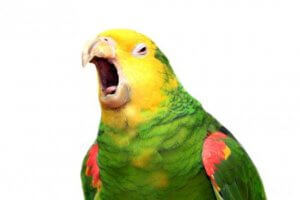Do Parrots Understand What They Say?


Written and verified by the lawyer Francisco María García
We all know that parrots have the admirable ability to reproduce different sounds, and that they can even articulate some words from human languages. However, do parrots understand what they’re saying, or are they just repeating what they hear? We’ll try to answer that question in today’s article.
Why can parrots imitate the sounds and words that they hear?
Some birds, like parrots and macaws, demonstrate a natural ability to imitate sounds that they hear in their environment. This incredible skill is because of the very special care these birds give to their syrinx, an organ that makes up their vocal system.
The syrinx is a bony box made up of fused and widened rings. The vibratory membranes and the division of the trachea, which helps form the bronchi, are found inside it.
The complexity of each bird’s sound is directly related to the structure of its syrinx. In addition to that, the size and shape of this organ varies greatly from species to species. The same goes for the vibratory membranes and the muscles that regulate their vibrations.
Generally, the more complex the structure of the syrinx, the more sophisticated and varied its vocal potential will be. Songbirds, like canaries, can handle a wide variety of sounds and melodies owing to the complexity of their syrinx.

So, what’s a parrot’s syrinx like?
When it comes to the complexity of its syrinx, parrots are more or less average on the scale of things. Having said that, these birds certainly know how to employ their skills very well. Their intelligence, expressiveness and predisposition to learning makes up for the simplicity of their syrinx.
It should be noted that there are several species of parrots, and each species has a different complexity in their syrinx. Among all these species, the red-tailed gray parrot is known to be the most talkative and intelligent.
In fact, all we need is the story of a famous gray parrot by the name of Alex to help us see whether parrots understand what they’re saying. Psychologist Irene Pepperberg did some research to show that these birds really do understand the meanings of words.
Do parrots understand what they say?
We’re now going to look at this research and get to know Irene and Alex’s story a little better. In the 1970s, Irene adopted Alex at a pet store when he was only 1 year old.
For 30 years, Irene devoted her time to training him, encouraging him to learn with different tests and using positive reinforcement training. The results were incredible. Alex learned to identify more than 50 objects by name and memorized more than 100 words.
In fact, Alex has come to demonstrate intelligence comparable to that of a five-year-old child. In a very impressive test, the bird was able to communicate the shape and color of an object after touching it. On top of that, Alex was able to distinguish numbers from 1 to 6, as well as several shapes and colors.
The ability to accurately communicate sensory perceptions requires an individual to really understand what he or she is saying. For a person to demonstrate that they understand the meaning of certain words, he must be able to express something that corresponds to reality.
So, the challenges that Alex was able to carry out are proof that parrots do understand what they say. Contrary to what we may think, they’re not just randomly repeating what they hear in exchange for a treat.

How can you test that parrots understand what they say?
This was probably the same question the scientific community asked when Irene came forth with her findings. So, the psychologist decided that she’d need to carry it out on a statistical level, to prove that Alex’s ability wasn’t just an isolated case or a ‘stroke of luck.’
Since Irene didn’t have access to other gray parrots to do her experiments on, she had to run tests with Alex over and over again. The problem was that, after doing the same test 10-20 times, the parrot became overwhelmed and stressed.
Unfortunately, Alex died shortly after that. He was only 31 years old, which is very young since red-tailed gray parrots can live in captivity for up to 50 years. So, Irene lost her friend as well as the center of her research.
No one can deny that Alex was an important point of reference for research into the intelligence of parrots. Thanks to his amazing ability, we are even closer to being able to confirm that parrots really do understand what they say.
We all know that parrots have the admirable ability to reproduce different sounds, and that they can even articulate some words from human languages. However, do parrots understand what they’re saying, or are they just repeating what they hear? We’ll try to answer that question in today’s article.
Why can parrots imitate the sounds and words that they hear?
Some birds, like parrots and macaws, demonstrate a natural ability to imitate sounds that they hear in their environment. This incredible skill is because of the very special care these birds give to their syrinx, an organ that makes up their vocal system.
The syrinx is a bony box made up of fused and widened rings. The vibratory membranes and the division of the trachea, which helps form the bronchi, are found inside it.
The complexity of each bird’s sound is directly related to the structure of its syrinx. In addition to that, the size and shape of this organ varies greatly from species to species. The same goes for the vibratory membranes and the muscles that regulate their vibrations.
Generally, the more complex the structure of the syrinx, the more sophisticated and varied its vocal potential will be. Songbirds, like canaries, can handle a wide variety of sounds and melodies owing to the complexity of their syrinx.

So, what’s a parrot’s syrinx like?
When it comes to the complexity of its syrinx, parrots are more or less average on the scale of things. Having said that, these birds certainly know how to employ their skills very well. Their intelligence, expressiveness and predisposition to learning makes up for the simplicity of their syrinx.
It should be noted that there are several species of parrots, and each species has a different complexity in their syrinx. Among all these species, the red-tailed gray parrot is known to be the most talkative and intelligent.
In fact, all we need is the story of a famous gray parrot by the name of Alex to help us see whether parrots understand what they’re saying. Psychologist Irene Pepperberg did some research to show that these birds really do understand the meanings of words.
Do parrots understand what they say?
We’re now going to look at this research and get to know Irene and Alex’s story a little better. In the 1970s, Irene adopted Alex at a pet store when he was only 1 year old.
For 30 years, Irene devoted her time to training him, encouraging him to learn with different tests and using positive reinforcement training. The results were incredible. Alex learned to identify more than 50 objects by name and memorized more than 100 words.
In fact, Alex has come to demonstrate intelligence comparable to that of a five-year-old child. In a very impressive test, the bird was able to communicate the shape and color of an object after touching it. On top of that, Alex was able to distinguish numbers from 1 to 6, as well as several shapes and colors.
The ability to accurately communicate sensory perceptions requires an individual to really understand what he or she is saying. For a person to demonstrate that they understand the meaning of certain words, he must be able to express something that corresponds to reality.
So, the challenges that Alex was able to carry out are proof that parrots do understand what they say. Contrary to what we may think, they’re not just randomly repeating what they hear in exchange for a treat.

How can you test that parrots understand what they say?
This was probably the same question the scientific community asked when Irene came forth with her findings. So, the psychologist decided that she’d need to carry it out on a statistical level, to prove that Alex’s ability wasn’t just an isolated case or a ‘stroke of luck.’
Since Irene didn’t have access to other gray parrots to do her experiments on, she had to run tests with Alex over and over again. The problem was that, after doing the same test 10-20 times, the parrot became overwhelmed and stressed.
Unfortunately, Alex died shortly after that. He was only 31 years old, which is very young since red-tailed gray parrots can live in captivity for up to 50 years. So, Irene lost her friend as well as the center of her research.
No one can deny that Alex was an important point of reference for research into the intelligence of parrots. Thanks to his amazing ability, we are even closer to being able to confirm that parrots really do understand what they say.
This text is provided for informational purposes only and does not replace consultation with a professional. If in doubt, consult your specialist.







